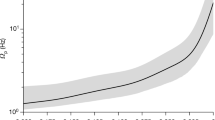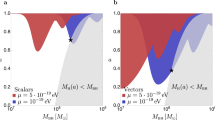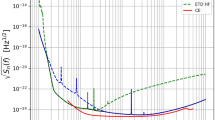Abstract
The direct detection of gravitational waves1,2,3,4 from merging binary black holes opens up a window into the environments in which binary black holes form. One signature of such environments is the angular distribution of the black hole spins. Binary systems that formed through dynamical interactions between already-compact objects are expected to have isotropic spin orientations5,6,7,8,9 (that is, the spins of the black holes are randomly oriented with respect to the orbit of the binary system), whereas those that formed from pairs of stars born together are more likely to have spins that are preferentially aligned with the orbit10,11,12,13,14. The best-measured combination of spin parameters3,4 for each of the four likely binary black hole detections GW150914, LVT151012, GW151226 and GW170104 is the ‘effective’ spin. Here we report that, if the magnitudes of the black hole spins are allowed to extend to high values, the effective spins for these systems indicate a 0.015 odds ratio against an aligned angular distribution compared to an isotropic one. When considering the effect of ten additional detections15, this odds ratio decreases to 2.9 × 10−7 against alignment. The existing preference for either an isotropic spin distribution or low spin magnitudes for the observed systems will be confirmed (or overturned) confidently in the near future.
This is a preview of subscription content, access via your institution
Access options
Access Nature and 54 other Nature Portfolio journals
Get Nature+, our best-value online-access subscription
$29.99 / 30 days
cancel any time
Subscribe to this journal
Receive 51 print issues and online access
$199.00 per year
only $3.90 per issue
Buy this article
- Purchase on Springer Link
- Instant access to full article PDF
Prices may be subject to local taxes which are calculated during checkout




Similar content being viewed by others
References
Abbott, B. P. et al. Observation of gravitational waves from a binary black hole merger. Phys. Rev. Lett. 116, 061102 (2016)
Abbott, B. P. et al. GW151226: observation of gravitational waves from a 22-solar-mass binary black hole coalescence. Phys. Rev. Lett. 116, 241103 (2016)
Abbott, B. P. et al. Binary black hole mergers in the first advanced LIGO observing run. Phys. Rev. X 6, 041015 (2016)
Abbott, B. P. et al. GW170104: observation of a 50-solar-mass binary black hole coalescence at redshift 0.2. Phys. Rev. Lett. 118, 221101 (2017)
Sigurdsson, S. & Hernquist, L. Primordial black holes in globular clusters. Nature 364, 423–425 (1993)
Portegies Zwart, S. F. & McMillan, S. L. W. Black hole mergers in the universe. Astrophys. J. 528, L17–L20 (2000)
Rodriguez, C. L. et al. Binary black hole mergers from globular clusters: implications for Advanced LIGO. Phys. Rev. Lett. 115, 051101 (2015)
Stone, N. C., Metzger, B. D. & Haiman, Z. Assisted inspirals of stellar mass black holes embedded in AGN discs: solving the ‘final au problem’. Mon. Not. R. Astron. Soc. 464, 946–954 (2017)
Rodriguez, C. L., Zevin, M., Pankow, C., Kalogera, V. & Rasio, F. A. Illuminating black hole binary formation channels with spins in Advanced LIGO. Astrophys. J. 832, L2 (2016)
Tutukov, A. V. & Yungelson, L. R. The merger rate of neutron star and black hole binaries. Mon. Not. R. Astron. Soc. 260, 675–678 (1993)
Belczynski, K., Holz, D. E., Bulik, T. & O’Shaughnessy, R. The first gravitational-wave source from the isolated evolution of two stars in the 40–100 solar mass range. Nature 534, 512–515 (2016)
Stevenson, S. et al. Formation of the first three gravitational-wave observations through isolated binary evolution. Nat. Commun. 8, 14906 (2017)
Mandel, I. & de Mink, S. E. Merging binary black holes formed through chemically homogeneous evolution in short-period stellar binaries. Mon. Not. R. Astron. Soc. 458, 2634–2647 (2016)
Marchant, P., Langer, N., Podsiadlowski, P., Tauris, T. M. & Moriya, T. J. A new route towards merging massive black holes. Astron. Astrophys. 588, A50 (2016)
Abbott, B. P. et al. The rate of binary black hole mergers inferred from Advanced LIGO observations surrounding GW150914. Astrophys. J. 833, L1 (2016)
Miller, M. C. & Miller, J. M. The masses and spins of neutron stars and stellar-mass black holes. Phys. Rep. 548, 1–34 (2015)
Vitale, S., Lynch, R., Sturani, R. & Graff, P. Use of gravitational waves to probe the formation channels of compact binaries. Class. Quantum Gravity 34, 03LT01 (2017)
King, A. R. & Kolb, U. The evolution of black hole mass and angular momentum. Mon. Not. R. Astron. Soc. 305, 654–660 (1999)
Fragos, T. & McClintock, J. E. The origin of black hole spin in galactic low-mass X-Ray binaries. Astrophys. J. 800, 17 (2015)
Kushnir, D., Zaldarriaga, M., Kollmeier, J. A. & Waldman, R. GW150914: spin-based constraints on the merger time of the progenitor system. Mon. Not. R. Astron. Soc. 462, 844–849 (2016)
Zaldarriaga, M., Kushnir, D. & Kollmeier, J. A. Research note: the expected spins of gravitational wave sources with isolated field binary progenitors. Preprint at https://arxiv.org/abs/1702.00885 (2017)
Hotokezaka, K. & Piran, T. Implications of the low binary black hole aligned spins observed by LIGO. Astrophys. J. 842, 111 (2017)
Albrecht, S., Reffert, S., Snellen, I. A. G. & Winn, J. N. Misaligned spin and orbital axes cause the anomalous precession of DI Herculis. Nature 461, 373–376 (2009)
Martin, R. G., Reis, R. C. & Pringle, J. E. Misalignment of the microquasar V4641 Sgr (SAX J1819.3−2525). Mon. Not. R. Astron. Soc. 391, L15–L18 (2008)
Morningstar, W. R. & Miller, J. M. The Spin of the black hole 4U 1543–47. Astrophys. J. 793, L33 (2014)
Kalogera, V. Spin-orbit misalignment in close binaries with two compact objects. Astrophys. J. 541, 319–328 (2000)
Farr, W. M., Kremer, K., Lyutikov, M. & Kalogera, V. Spin tilts in the double pulsar reveal supernova spin angular-momentum production. Astrophys. J. 742, 81 (2011)
Gerosa, D., Kesden, M., Sperhake, U., Berti, E. & O’Shaughnessy, R. Multi-timescale analysis of phase transitions in precessing black-hole binaries. Phys. Rev. D 92, 064016 (2015)
Schnittman, J. D. Spin-orbit resonance and the evolution of compact binary systems. Phys. Rev. D 70, 124020 (2004)
Bogdanovic´, T., Reynolds, C. S. & Miller, M. C. Alignment of the spins of supermassive black holes prior to coalescence. Astrophys. J. 661, L147–L150 (2007)
Abbott, B. P. et al. Properties of the binary black hole merger GW150914. Phys. Rev. Lett. 116, 241102 (2016)
Stevenson, S., Berry, C. P. L. & Mandel, I. Hierarchical analysis of gravitational-wave measurements of binary black hole spin–orbit misalignments. Mon. Not. R. Astron. Soc. https://doi.org/10.1093/mnras/stx1764 (2017)
Veitch, J. et al. Parameter estimation for compact binaries with ground-based gravitational-wave observations using the LALInference software library. Phys. Rev. D 91, 042003 (2015)
Hogg, D. W., Myers, A. D. & Bovy, J. Inferring the eccentricity distribution. Astrophys. J. 725, 2166–2175 (2010)
Mandel, I. Parameter estimation on gravitational waves from multiple coalescing binaries. Phys. Rev. D 81, 084029 (2010)
Fishbach, M., Holz, D. E. & Farr, B. Are LIGO’s black holes made from smaller black holes? Astrophys. J. 840, L24 (2017)
Gerosa, D. & Berti, E. Are merging black holes born from stellar collapse or previous mergers? Phys. Rev. D 95, 124046 (2017)
Abbott, B. P. et al. GW150914: first results from the search for binary black hole coalescence with Advanced LIGO. Phys. Rev. D 93, 122003 (2016)
Abbott, B. P. et al. Effects of waveform model systematics on the interpretation of GW150914. Classic. Quantum Grav. 34, 104002 (2017)
Abbott, B. P. et al. Directly comparing GW150914 with numerical solutions of Einstein’s equations for binary black hole coalescence. Phys. Rev. D 94, 064035 (2016)
Bezanson, J., Karpinski, S., Shah, V. B. & Edelman, A. Julia: a fast dynamic language for technical computing. Preprint at https://arxiv.org/abs/1209.5145 (2012)
van der Walt, S., Colbert, S. C. & Varoquaux, G. The NumPy array: a structure for efficient numerical computation. Comput. Sci. Eng. 13, 22–30 (2011)
Jones, E. et al. SciPy: open source scientific tools for Python, http://www.scipy.org/ (2001; accessed 24 May 2017)
Hunter, J. D. Matplotlib: a 2D graphics environment. Comput. Sci. Eng. 9, 90–95 (2007)
Perez, F. & Granger, B. E. IPython: a system for interactive scientific computing. Comput. Sci. Eng. 9, 21–29 (2007)
Acknowledgements
We thank R. O’Shaughnessy, C. Berry, D. Gerosa and S. Vitale for discussions and comments on this work. W.M.F., S.S., I.M. and A.V. were supported in part by the STFC. M.C.M. acknowledges support of the University of Birmingham Institute for Advanced Study Distinguished Visiting Fellows programme. S.S. and I.M. acknowledge support from the National Science Foundation under grant number NSF PHY11-25915.
Author information
Authors and Affiliations
Contributions
All authors contributed at all stages to the work presented here.
Corresponding author
Ethics declarations
Competing interests
The authors declare no competing financial interests.
Additional information
Reviewer Information Nature thanks I. Bartos and S. Sigurdsson for their contribution to the peer review of this work.
Publisher's note: Springer Nature remains neutral with regard to jurisdictional claims in published maps and institutional affiliations.
Extended data figures and tables
Extended Data Figure 1 Distributions of spin magnitudes.
See equation (1) for the definition of the ‘low’ (blue line), ‘flat’ (green line) and ‘high’ (red line) magnitude distributions. The distributions have mean spins of 0.33, 0.5 and 0.67, and standard deviations of 0.24, 0.29 and 0.24, respectively.
Extended Data Figure 2 Fraction of the binary black hole population that comes from an isotropic distribution under a mixture model.
The blue dotted line shows the flat prior on the fraction fi of binary black holes that come from an isotropic distribution, under the mixture model. The three red lines show the posterior on fi after LIGO O1 and GW170104 with our various assumptions regarding black hole spin magnitudes. The solid line shows the posterior assuming that all black holes have their spin magnitude drawn from the flat distribution. The dashed line assumes the high black hole spin magnitude distribution p(a) = 2a. The dash-dotted line assumes the low distribution p(a) = 2(1 − a). For a wide range of assumptions regarding black hole spin magnitudes, the fraction coming from an isotropic distribution fi peaks at 1.
Extended Data Figure 3 Effect of small spins on the ratio of isotropic and aligned models.
The blue line shows the ratio (plotted as the equivalent σ) between a model in which all systems are from an isotropic distribution and one in which all systems are aligned (σI/A), as a function of the power-law exponent α in equation (3). The top axis shows the mean spin magnitude  to which the given value of α corresponds. For mean spin magnitudes of less than about 0.2, we find no evidence for either distribution over the other.
to which the given value of α corresponds. For mean spin magnitudes of less than about 0.2, we find no evidence for either distribution over the other.
Extended Data Figure 4 Distributions of χeff assuming all merging black holes have equal masses (q = 1) or a 2:1 mass ratio (q = 0.5).
The details of the distribution are sensitive to the mass ratio, but in our analysis the primarily sensitivity is to the changing sign of χeff under the isotropic models. This latter property is unchanged under changing mass ratio.
Extended Data Figure 5 Widths of the 90% credible intervals for χeff for 500 binaries in a simulated detected population.
χeff is better constrained for systems with high χeff and high mass ratio. χsim and qsim are the simulated effective spin and mass ratio, respectively.
Rights and permissions
About this article
Cite this article
Farr, W., Stevenson, S., Miller, M. et al. Distinguishing spin-aligned and isotropic black hole populations with gravitational waves. Nature 548, 426–429 (2017). https://doi.org/10.1038/nature23453
Received:
Accepted:
Published:
Issue Date:
DOI: https://doi.org/10.1038/nature23453
This article is cited by
-
The formation of merging black holes with masses beyond 30 M⊙ at solar metallicity
Nature Astronomy (2023)
-
Astrophysics with the Laser Interferometer Space Antenna
Living Reviews in Relativity (2023)
-
Rates of compact object coalescences
Living Reviews in Relativity (2022)
-
On the beyond-Newtonian collinear circular restricted $(3 + 1)$-body problem with spinning primaries
Astrophysics and Space Science (2022)
-
General-relativistic precession in a black-hole binary
Nature (2022)
Comments
By submitting a comment you agree to abide by our Terms and Community Guidelines. If you find something abusive or that does not comply with our terms or guidelines please flag it as inappropriate.



